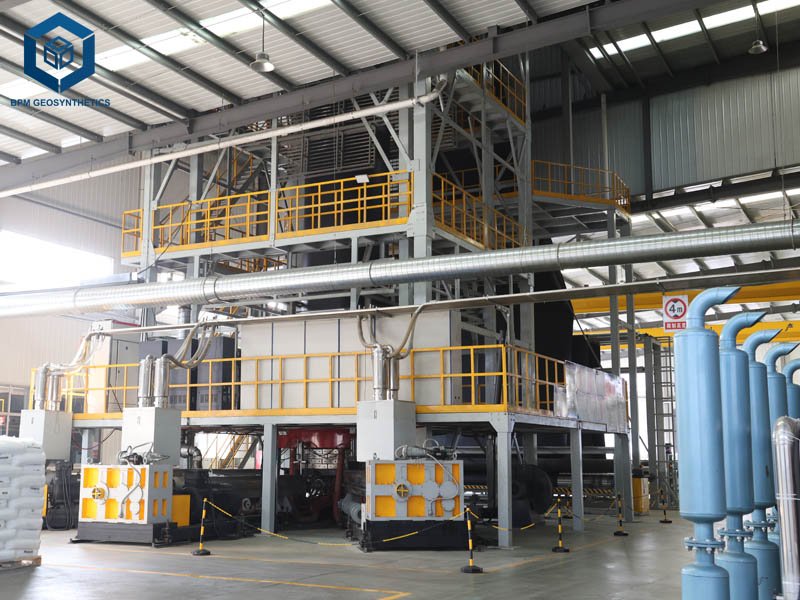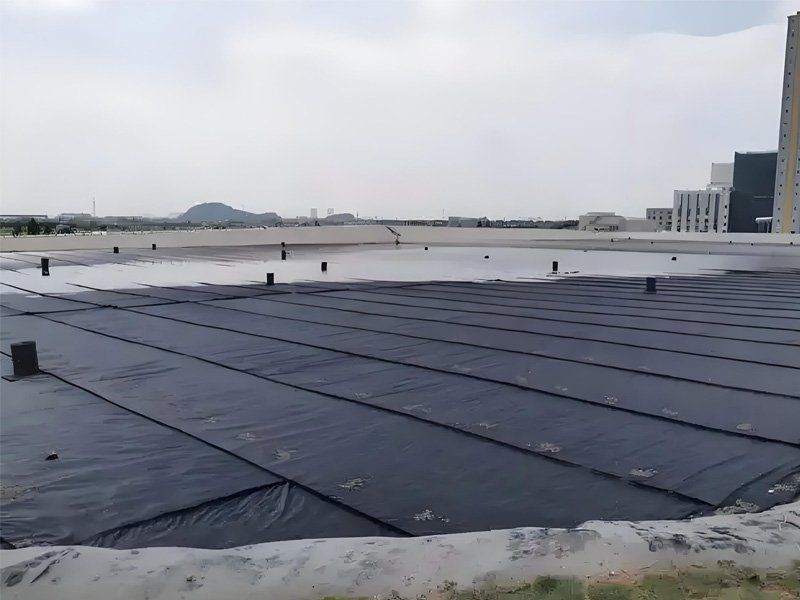Pond liner thickness can vary depending on the specific requirements of the pond or water containment project. The thickness of a pond liner is an important factor that influences its durability, puncture resistance, and overall effectiveness in preventing leaks and seepage. 300 micron pond liner is a type of pond liner that is 300 microns thick, equivalent to 0.3 millimeters. In this article, we will talk about BPM Geomembrane Pond Liner and its applications.
1. What Is 300 micron Pond Liner?
Pond liners are synthetic membranes utilized in a multitude of civil and environmental engineering projects. The thickness of a pond liner is a crucial attribute that dictates its efficacy and appropriateness for distinct purposes. A 300-micron pond liner signifies a thickness of 0.3mm or 11 mils, playing a significant role in its performance and application suitability.
Features of 300 micron pond liner
- Puncture Resistance: Despite its relatively thin profile, a 300 micron pond liner offers decent puncture resistance, safeguarding against damage from sharp objects or roots.
- Flexibility: The material is flexible, allowing it to conform to the shape of the pond or water feature without compromising its integrity.
- Waterproof: The liner effectively prevents water seepage, ensuring efficient water containment within the pond or water feature.
- Chemical Resistance: It exhibits resistance to chemicals, protecting the liner from degradation when exposed to various water treatments or environmental factors.
- UV Stability: Some 300 micron pond liners are equipped with UV stabilizers to withstand prolonged exposure to sunlight without deteriorating.
- Ease of Installation: These liners are relatively easy to install, making them suitable for DIY projects or professional installations.
- Cost-Effective: Compared to thicker liners, a 300 micron pond liner can be a cost-effective solution for smaller ponds or water features.


2. What Are The Factors That Affect The Cost Of 300 Micron Pond Liner?
The cost of a 300 micron HDPE pond liner in industrial projects is influenced by several factors:
2.1 300 Micron Pond Liner – Material Cost:
The price of HDPE can fluctuate due to market demand and supply, as well as changes in crude oil prices. For example, in a large chemical plant’s cooling water pond project, an increase in HDPE prices would correspondingly raise the overall cost of the pond liner.
2.2 300 Micron Pond Liner – Installation Difficulty:
Projects with complex terrain, harsh construction conditions, or requiring special installation techniques will have higher installation costs. For instance, constructing a reservoir in a mountainous area or on a steep slope may necessitate more labor and equipment to properly lay the HDPE pond liner.
2.3 300 Micron Pond Liner – Project Scale:
Larger projects typically require more materials and labor, thus increasing costs. For example, a hydroelectric power station’s reservoir may need thousands of square meters of HDPE pond liner, which is much more expensive than a small landscape pond.
2.4 300 Micron Pond Liner – Transportation Expenses:
If the project site is far from the supplier, transportation costs can significantly add to the total expense. For instance, a tailings storage facility project in a remote mining area might require transporting the HDPE pond liner from hundreds of kilometers away, increasing the overall cost.
2.5 300 Micron Pond Liner – Brand and Quality:
Different brands of HDPE pond liners may vary in quality and price. Opting for a well-known brand might be more costly but usually ensures higher quality and longer lifespan. For example, in industrial projects with high water quality requirements, such as a semiconductor manufacturing plant’s water treatment system, a higher quality HDPE pond liner might be chosen.
2.6 300 Micron Pond Liner – Design Requirements:
Special design requirements, such as UV resistance or chemical resistance, can also affect the cost of the HDPE pond liner. For instance, an industrial tank used for storing chemicals might need an HDPE pond liner made with a special formula to withstand chemical corrosion.
3. What Are The Applications Of 300 Micron Pond Liner?
A 300 micron pond liner, particularly one made from high-density polyethylene (HDPE) like the BPM Geosynthetics geomembrane, has several key applications in industrial projects. Here are some examples:
3.1 Mining and Tailings Storage:
In mining operations, 300 micron HDPE liners such as those from BPM Geosynthetics are used in tailings storage facilities (TSFs) to contain mine waste and prevent environmental contamination. The liner acts as a barrier to leachate and other pollutants, ensuring environmental compliance and safety. For example, a large copper mine might use these liners to line vast tailings impoundments, protecting local ecosystems from acid mine drainage and heavy metal pollution.
3.2 Wastewater Treatment Plants:
Industrial wastewater treatment plants utilize 300 micron HDPE pond liners in lagoons and clarifiers to manage and treat wastewater before discharge or reuse. The liner prevents seepage into the ground, containing hazardous substances and allowing for effective water treatment processes. For instance, a petrochemical plant might employ such liners in its wastewater management systems to handle complex chemical mixtures safely.
3.3 Containment Basins and Secondary Containment:
In industries dealing with hazardous materials or chemicals, secondary containment basins lined with 300 micron HDPE are crucial for preventing leaks and spills. These basins capture any accidental releases, preventing environmental contamination. An oil refinery, for example, might use these liners in secondary containment areas around storage tanks and processing equipment to mitigate risks associated with potential hydrocarbon leaks.
3.4 Aquaculture Systems:
In industrial aquaculture, where fish farming is done on a large scale, 300 micron HDPE pond liners create controlled environments for fish rearing. These liners help maintain water quality by preventing seepage and contamination from surrounding soils. A commercial fish farm, for instance, might use BPM Geosynthetics liners to ensure optimal conditions for fish growth while minimizing environmental impact.
3.5 Landfill Liners:
Industrial landfills often use 300 micron HDPE geomembranes as liners to prevent leachate from contaminating the surrounding environment. These liners provide a durable and impermeable barrier that complies with stringent environmental regulations. For example, an industrial waste disposal site might use BPM Geosynthetics liners to protect groundwater and soil from hazardous waste.
3.6 Reservoirs and Dams:
Large reservoirs and dams use 300 micron HDPE pond liners to prevent water loss through seepage and to protect the structural integrity of the dam. These liners are essential for maintaining water levels and ensuring the longevity of the dam structure. For instance, a hydroelectric dam might use BPM Geosynthetics liners to enhance its water retention capabilities and overall stability.
In conclusion, the 300 micron HDPE pond liner from BPM Geosynthetics finds extensive applications across various industrial projects, providing reliable waterproof protection and environmental safety.


4. How To Choose The Right 300 Micron Pond Liner?
Choosing the right 300 micron pond liner, particularly one made from high-density polyethylene (HDPE) like BPM Geomembrane, involves several considerations to ensure it meets your specific needs. Here are key factors to consider:
4.1 Purpose and Application:
Determine the primary use of the pond liner. Is it for containment of hazardous materials, wastewater treatment, mining operations, or aquaculture? Different applications may require specific features such as chemical resistance, UV protection, or mechanical strength. For instance, a mining operation might prioritize liners with enhanced durability and resistance to acids and heavy metals.
4.2 Material Quality:
Ensure the HDPE geomembrane is of high quality. BPM Geomembrane is known for its robustness and reliability. Check for certifications and standards compliance, such as ISO or ASTM, to guarantee the material’s performance and safety. High-quality HDPE will offer better longevity and effectiveness in harsh conditions.
4.3 Thickness and Durability:
A 300 micron thickness is suitable for most industrial applications, providing a balance between flexibility and durability. However, assess if your project requires a thicker or thinner liner based on the expected mechanical stress and environmental conditions. For example, a landfill might need a thicker liner to withstand heavy loads and prevent punctures.
4.4 Environmental Conditions:
Consider the environmental conditions where the liner will be installed. Factors such as temperature extremes, UV exposure, and chemical exposure can affect the liner’s performance. BPM Geomembrane offers options with UV stabilizers and other additives to enhance resistance to these conditions. For outdoor installations, UV protection is crucial to prevent degradation over time.
4.5 Installation Ease:
The ease of installation is another important factor. BPM Geomembrane products are designed for straightforward installation, which can save time and reduce labor costs. Ensure that the liner can be easily handled and fitted into the desired area without excessive seaming or complex procedures. Proper installation is critical for the liner’s effectiveness.
4.6 Manufacturer Reputation:
Choose a reputable manufacturer like BPM Geosynthetics, known for producing reliable and high-performance geomembranes. Research customer reviews, testimonials to gauge the product’s real-world performance and the manufacturer’s customer support. A well-regarded manufacturer often provides better warranties and after-sales service.
4.7 Cost vs. Performance:
While cost is a significant factor, it should not compromise the liner’s quality and performance. BPM Geomembrane offers a good balance of cost-effectiveness and high performance. Evaluate the total cost of benefits, including installation, maintenance, and potential savings from preventing environmental damage or contamination.
4.8 Customization Options:
Some projects may require customized solutions, such as specific dimensions, seams, or additional features like anchoring systems. BPM Geosynthetics can provide tailored products to meet unique project requirements, ensuring optimal fit and performance. Customization can enhance the liner’s effectiveness and integration into the project.
5. Summary
The 300 micron pond liner serves as a critical component in various civil and environmental engineering projects. Its versatility, impermeability, durability, and cost-effectiveness make it valuable in applications such as landfills, mining operations, agriculture, environmental remediation, erosion control, and more. As technology progresses, these pond liners continue to advance, offering innovative solutions for the challenges encountered in different industries. BPM Pond Liner is the leading pond liner manufacturer and supplier. For any questions or inquiries, please contact us.





